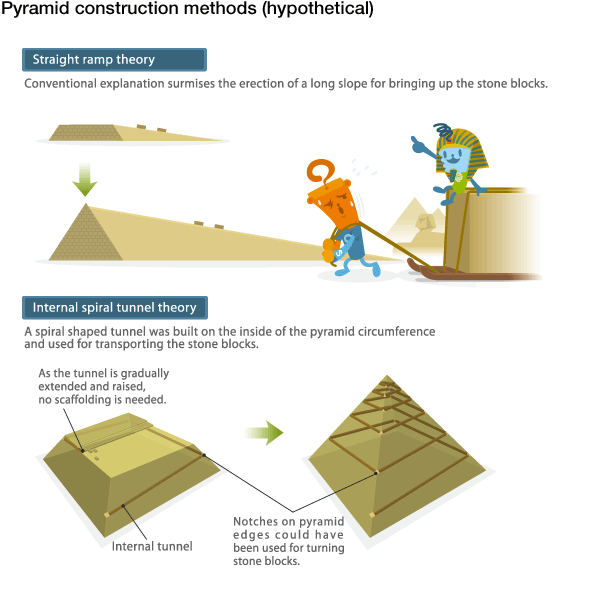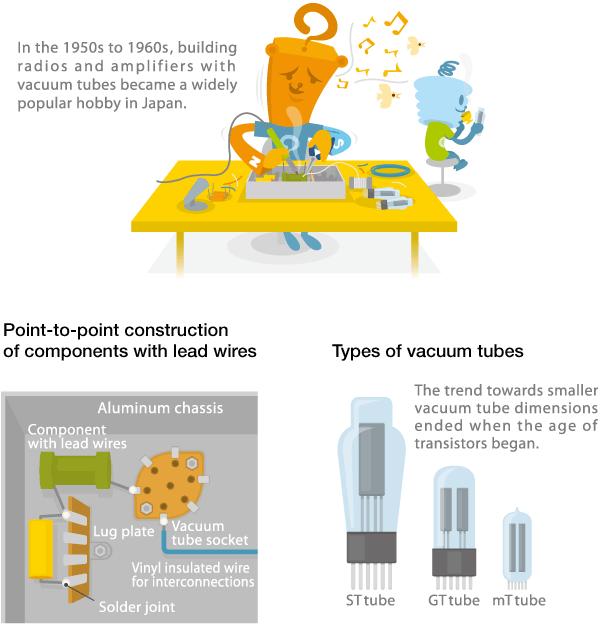The Wonders of Electromagnetism
Visualizing the Invisible: Coils Capture Changes in Magnetic Fields

Many people feel nervous when passing through the security screening gate at an airport, even when they have nothing to hide. All too often, a beep goes off, prompting a search of your pockets—only to reveal forgotten keys or coins. While anti-theft gates in retail stores utilize radio waves, airport gates operate on the same principle as metal detectors: they detect the passage of metal objects by measuring subtle changes in coil-generated magnetic fields.
Metal detectors enable nondestructive testing of bridges and tunnels
In Japan, the aging of bridges and tunnels built during the high economic growth period between the 1950s and 1970s is emerging as a serious issue. According to a survey by the country’s Ministry of Land, Infrastructure, Transport and Tourism, there are roughly 730,000 road bridges with a length of 2 meters or more and 11,000 tunnels nationwide. By 2030, more than half of the bridges and over one-third of the tunnels will have exceeded the typical design life of 50 years.
Aging bridges and tunnels pose the risk of sudden, disastrous collapses, potentially resulting in human casualties. Since the 2011 Great East Japan Earthquake, frequent earthquakes in various regions have rendered many old bridges and tunnels unusable due to steel fractures, cracks, deformations, or even outright collapse.
Sudden failures of bridges and tunnels can hinder the movement of people and goods, significantly impacting people’s lives. Rebuilding them, on the other hand, incurs massive costs. Consequently, they tend to be used for as long as possible, often beyond their originally intended lifespan, relying solely on ongoing safety checks.
To ensure the safety of bridges, tunnels, and other structures, there is a growing emphasis on the concept of preventive maintenance, which involves conducting periodic inspections and addressing issues before they escalate. In recent years, the utilization of drones for visual inspection has become common, enabling the detection of anomalies in elevated or secluded areas that were previously inaccessible. Still, even when external appearances look normal, rebar corrosion or concrete cracks may be progressing inside, reducing structural strength. This has raised the value of non-destructive testing, a category of techniques to examine the internal condition of structures without causing damage.
Non-destructive inspection methods for buildings include X-ray and ultrasound, but using a metal detector is the most straightforward. Simply sweeping a metal detector across the surface of a building can pinpoint the position of rebar and other metallic materials. Its working principle is based on a coil with an alternating current running through it. When a metal object like iron comes close, it creates a disturbance in the magnetic field generated by the search coil, which is then amplified to inform the user with a buzzer or meter. While it cannot probe deep inside the concrete, it can confirm the presence of rebar near the surface. Portable and handheld types are used to sweep war zones for buried landmines, hunt for hidden treasures, or used as security tools to inspect individuals for concealed knives or firearms.
Walk-through security gates at airports are also metal detectors that work under the same principle. However, it is important to note that it can respond to metals embedded in the body, such as bolts used to treat bone fractures and heart pacemakers. In such cases, presenting appropriate documentation can allow passengers to bypass the gate.

Magnetic field lines reveal the link between the direction of an electric current and a magnetic field
Although the magnetic field produced around a permanent magnet or electromagnet is invisible to the naked eye, its strength and direction can be determined by tracing its magnetic field lines. Observing the changes in the magnetic field lines can help explain how a metal detector detects magnetic field disturbances when metal objects are brought close to its coil-based electromagnet. Iron, among other metals, interacts particularly strongly with magnetism because it readily absorbs magnetic field lines.
When Hans Christian Ørsted first discovered the magnetic effect of electric current in 1820, the concept of magnetic field lines did not yet exist, making it impossible to theoretically consider aspects like the direction and strength of a magnetic field. In earlier days, magnetism was even perceived as some sort of remote telepathy.
André-Marie Ampère was the first to analyze the dynamics of the magnetic effect of electric currents. Soon after replicating Ørsted’s experiment, Ampère identified a consistency between the current and the direction in which a magnetic needle pointed. Described in plain words, “If a person imagines oneself aligned with the direction of the current, where the current enters from the feet and leaves out of the head, and a magnetic needle is in front of the face, then the needle’s north pole always deflects towards the left hand.” This memory aid was referred to as Ampère’s swimming rule because, from the perspective of an imaginary swimmer, a magnetic needle’s north pole would always deflect leftward. It was later simplified into Ampère’s right-hand grip rule (magnetic field lines are generated in a clockwise direction to the direction of the current).
Ampère subsequently reasoned that a magnetic effect should appear between two current-carrying conductors and constructed a clever apparatus where a suspended coil could rotate while current flowed through it. It confirmed the presence of an attractive force between two conductors when the currents flowed in the same direction, and a repulsive force when they flowed in opposite directions (see Figure A). Using the right-hand rule, it is easy to determine whether an attractive or repulsive force is exerted on the two current-carrying conductors. Imagine there are invisible bar magnets aligned with the magnetic field lines, as shown in Figure B. When the magnetic field lines are in opposite directions, it is equivalent to the bar magnets oriented in opposite directions, resulting in attraction between the opposite poles. Conversely, when the magnetic field lines are in the same direction, the bar magnets are oriented in the same direction, resulting in repulsion. The denser the magnetic field lines, the stronger the attraction or repulsion.
The unit of electric current, ampere (A), is named after Ampère’s achievements. One ampere (1A) is defined as the current passing through two parallel wires one meter apart that produces a magnetic force of 2 x 10−7 newtons per meter.
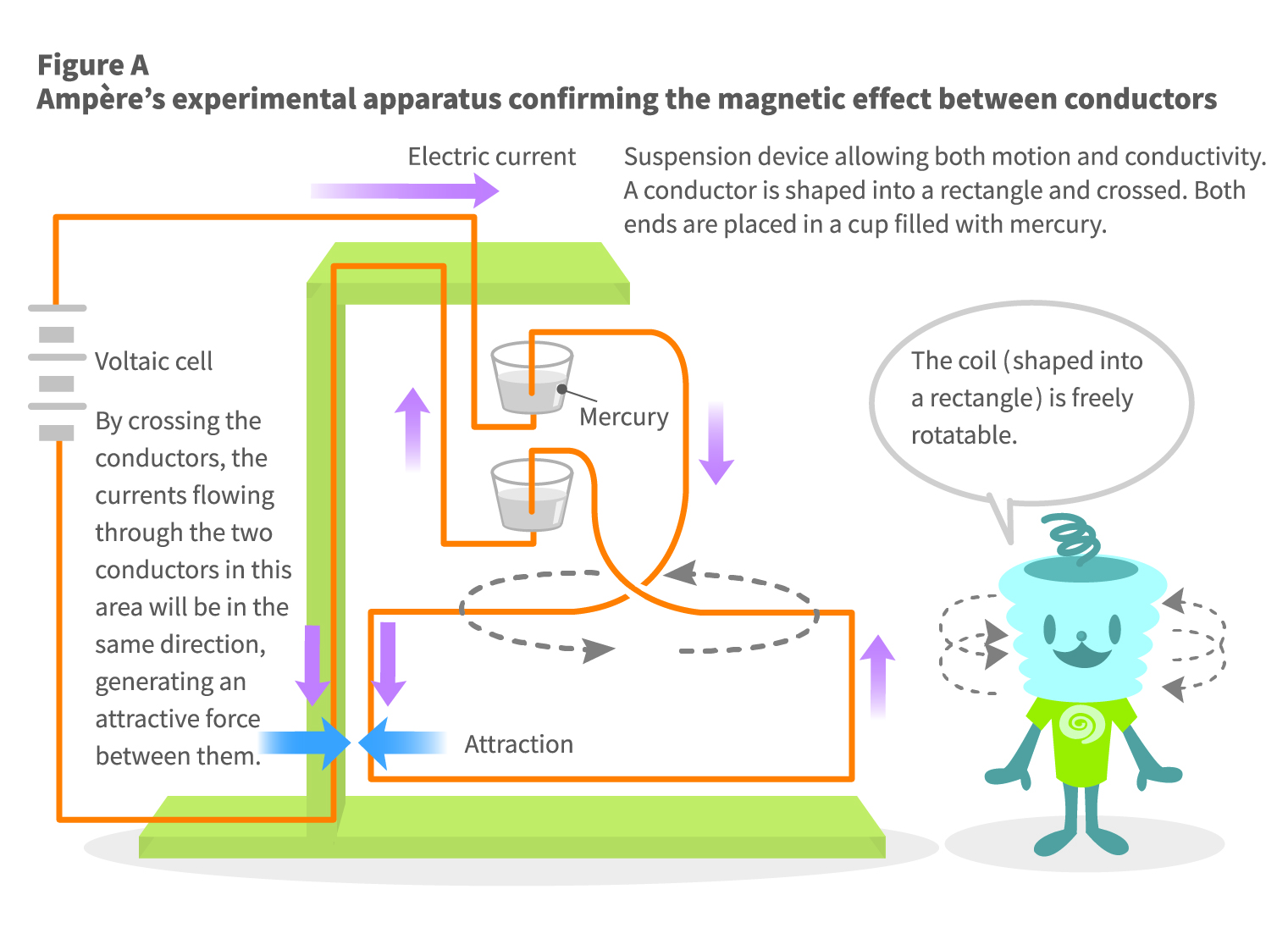
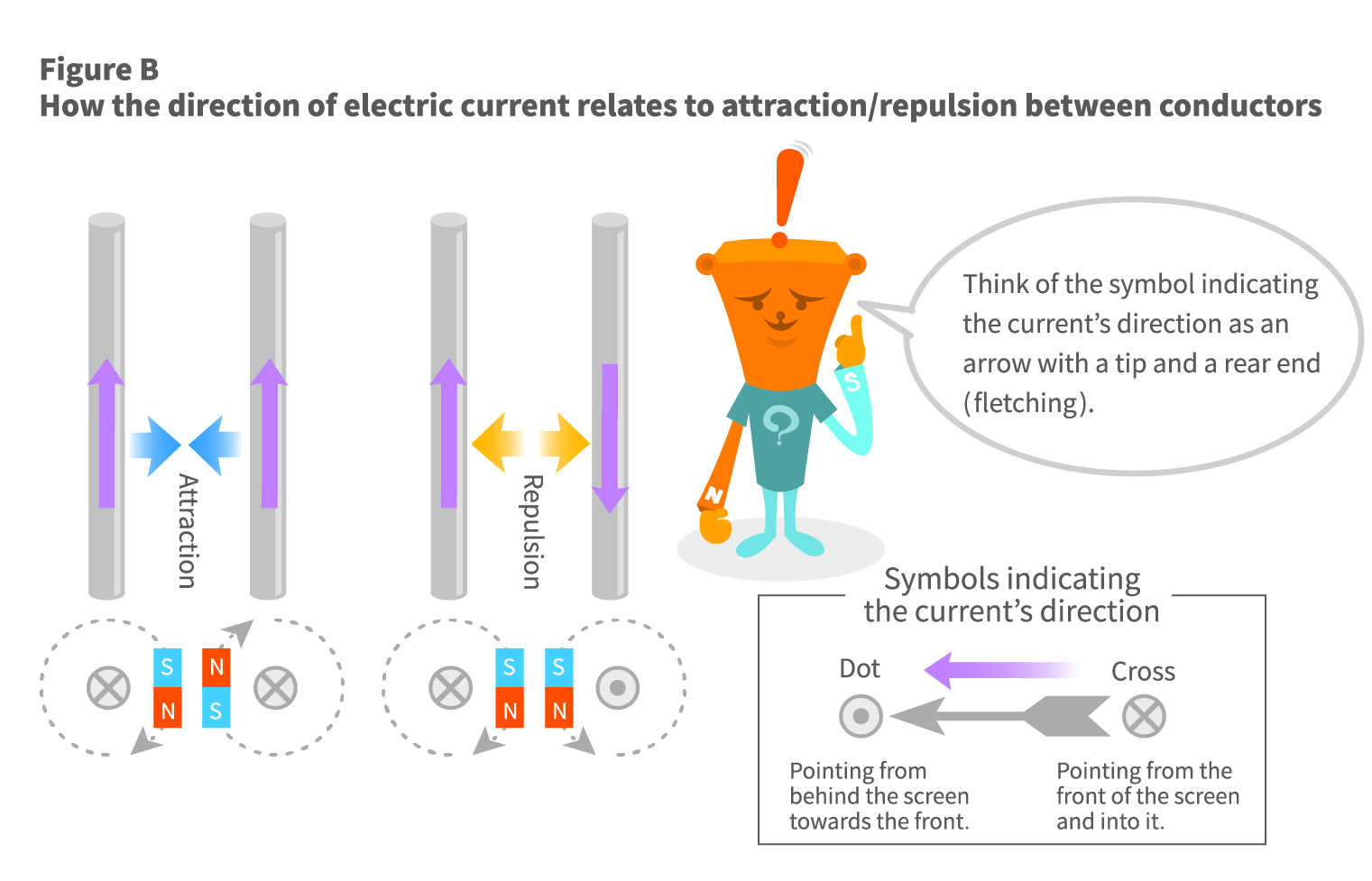
Measuring biomagnetism by canceling out the effects of magnetic noise using reverse-wound coils
Interference from geomagnetism (Earth’s magnetic field) cannot be ignored when measuring faint magnetic effects. Ampère recognized this problem and designed a unique coil system unaffected by geomagnetism, where the coils are wound in opposite directions from the center to each end (see Figure C, left). As evident from the right-hand rule, the magnetic fields generated by the coils on the left and right sides are in opposite directions, canceling each other out.
Additionally, a repulsive force acts in response to geomagnetism at the spiraled section on one end, while an attractive force acts on the other, preventing geomagnetism from causing any rotational motion. Ampère also devised a geomagnetism-agnostic magnetic needle by stacking two magnetic needles of the same size and strength in opposite directions (see Figure C, right).
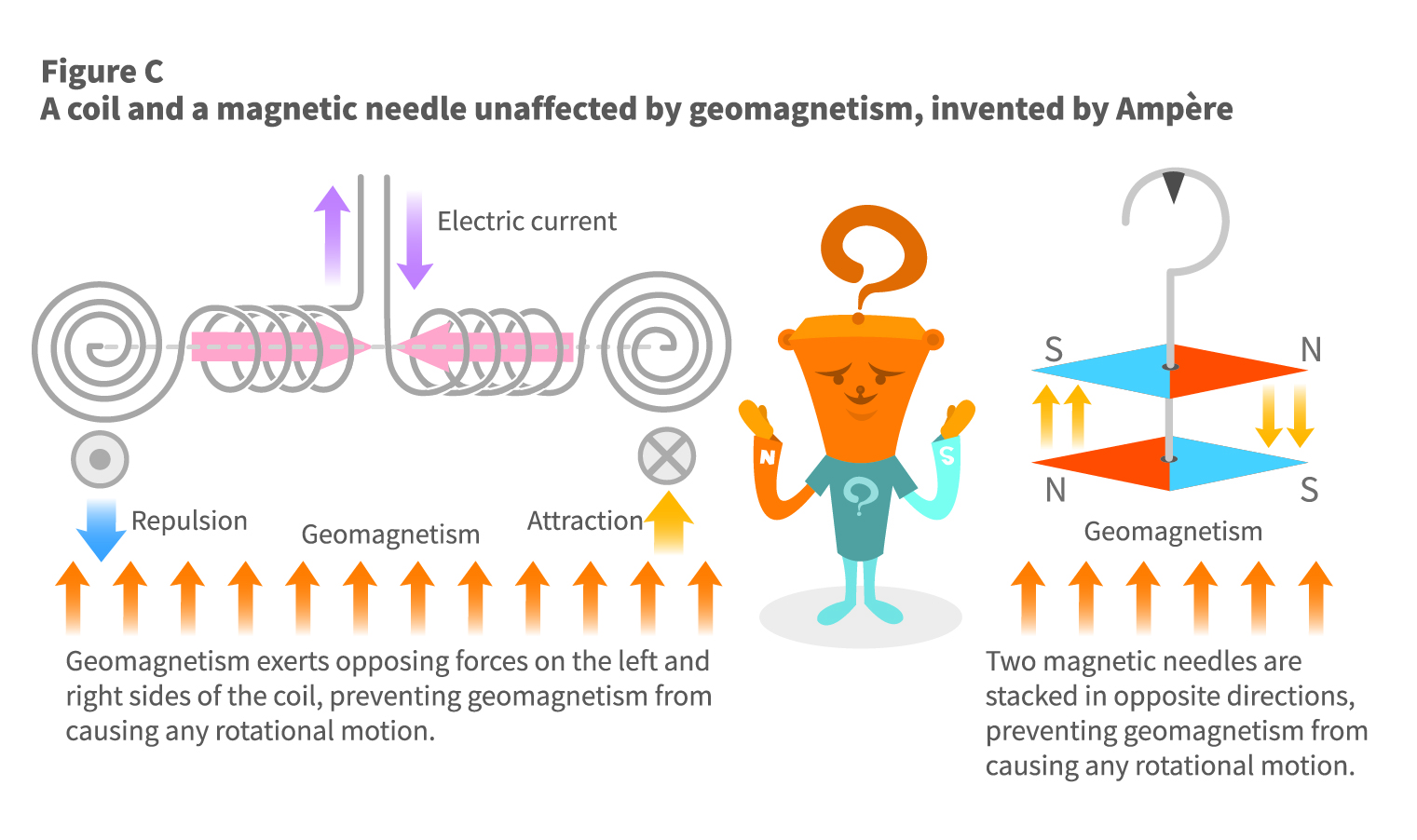
The strength of geomagnetism is approximately 0.5 gauss, which is several thousand to several tens of thousands of times weaker than a typical permanent magnet. Even more subtle are biomagnetic fields, such as those generated by the heart or the brain. Biomagnetic fields are far weaker than geomagnetism at only one millionth to one billionth the strength. Traditionally, these extremely delicate magnetic fields have exceeded the detection limits of conventional magnetometers, posing challenges to measurements. However, beginning in the 1970s, the development of a class of highly sensitive magnetometers called SQUID (Superconducting Quantum Interference Device) based on superconductors has significantly advanced the field of biomagnetic research, overcoming the limitations of conventional instruments.
SQUIDs, like metal detectors, detect changes in magnetic fields using coils. However, we are surrounded by various sources of magnetic noise beyond geomagnetism, including electronic devices, which can easily drown out the faint biomagnetic fields. Initially, SQUID measurements required robust magnetically shielded rooms, but the invention of noise-canceling detection coils made simpler shielding adequate. These coils add a coil wound in the reverse direction above the detection coil (see Figure D). Because the strength of magnetic fields from a distant source is nearly uniform, a pair of coils wound in opposite directions will cancel them out, enhancing the resolution of the biomagnetic measurements.
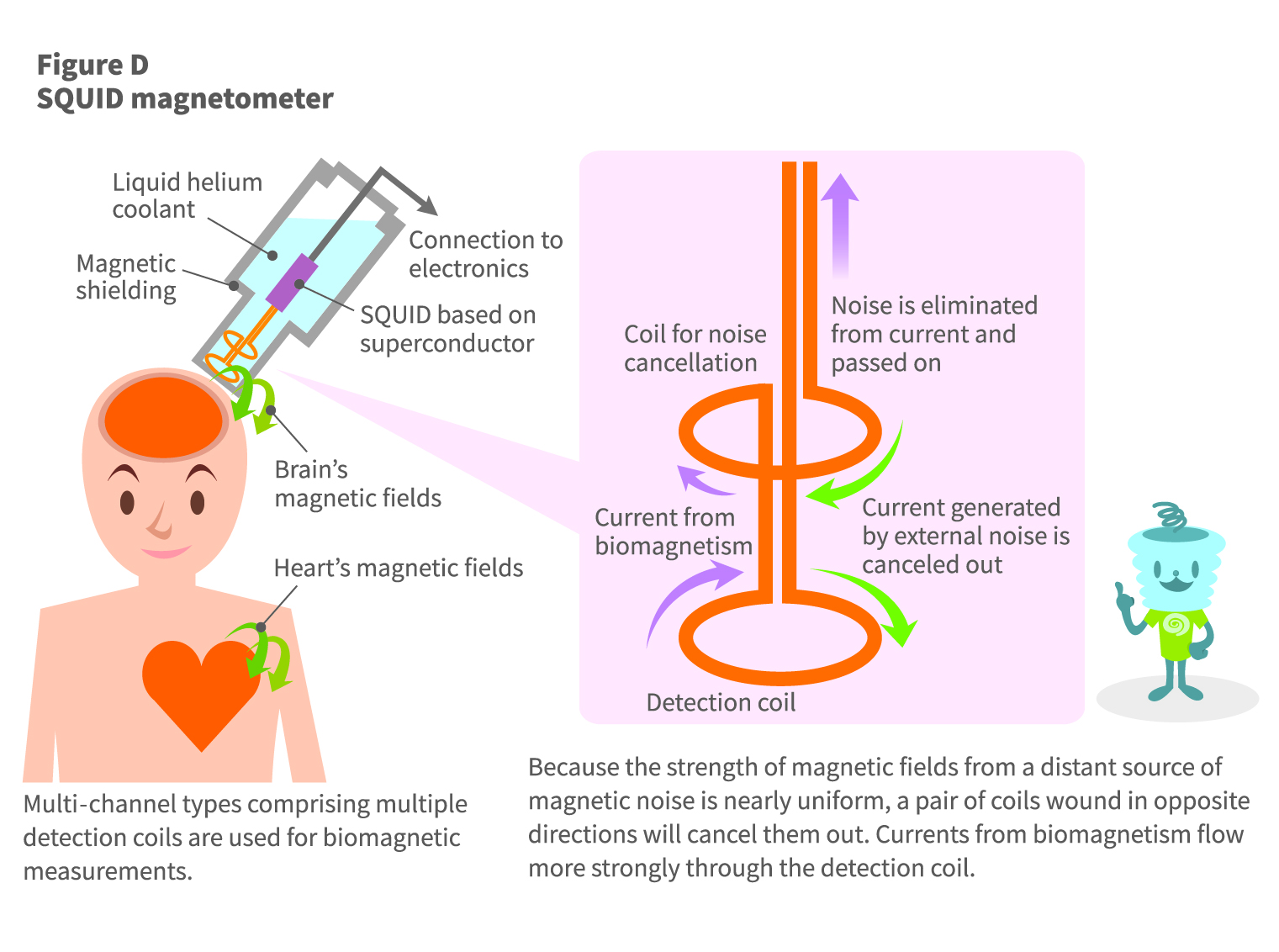
Magnetoencephalography (MEG), a brain imaging technique that measures magnetic fields occurring in the brain, visualizes the regions of brain activity. Information is transmitted in the brain through the exchange of electrical signals between neurons. With traditional electroencephalography (EEG), where electrodes are directly attached to the head to measure electrical signals inside the brain, it is difficult to accurately identify the source of signals due to the varying conductivity of tissues like the skin and skull. By measuring the magnetic fields generated by these electrical signals, MEG eliminates the interference from the materials between the targeted area and the signal source, enabling precise localization.
The introduction of SQUID-based MEG made it possible to pinpoint the location of abnormal neuron excitation that causes epilepsy. This substantially contributed to the diagnosis and treatment of epilepsy, particularly in improving the success rate of surgical treatment of drug-resistant epilepsy. Additionally, MEG is utilized for studying changes in the brain related to sensation, perception, movement, and language, as well as higher-order functions like cognition and working memory.
TDK is a comprehensive electronic components manufacturer leading the world in magnetic technology



